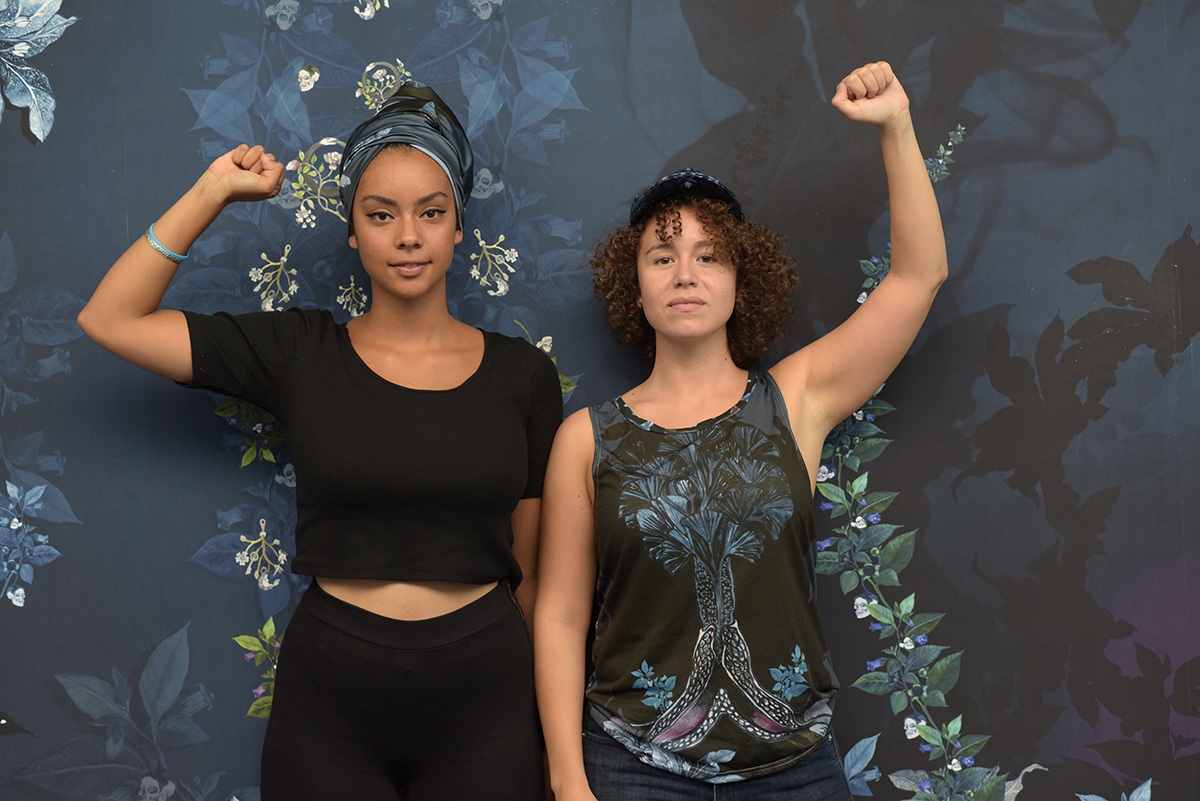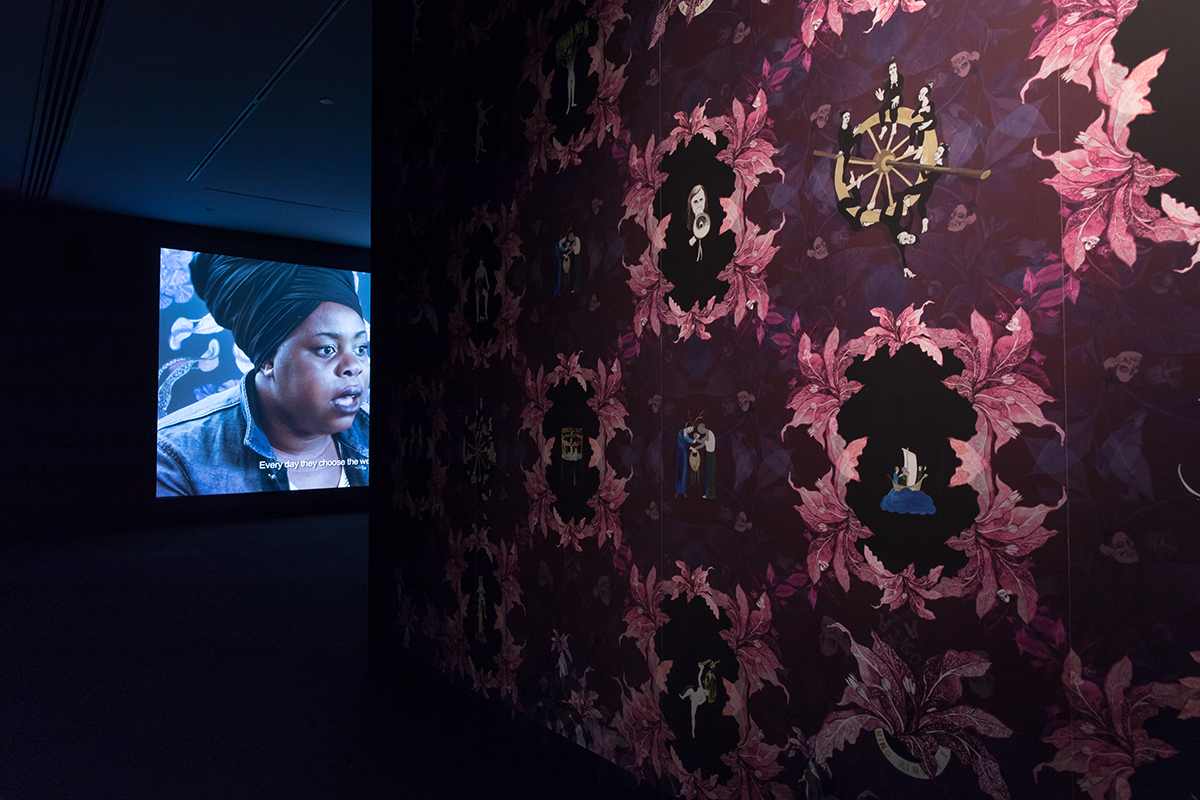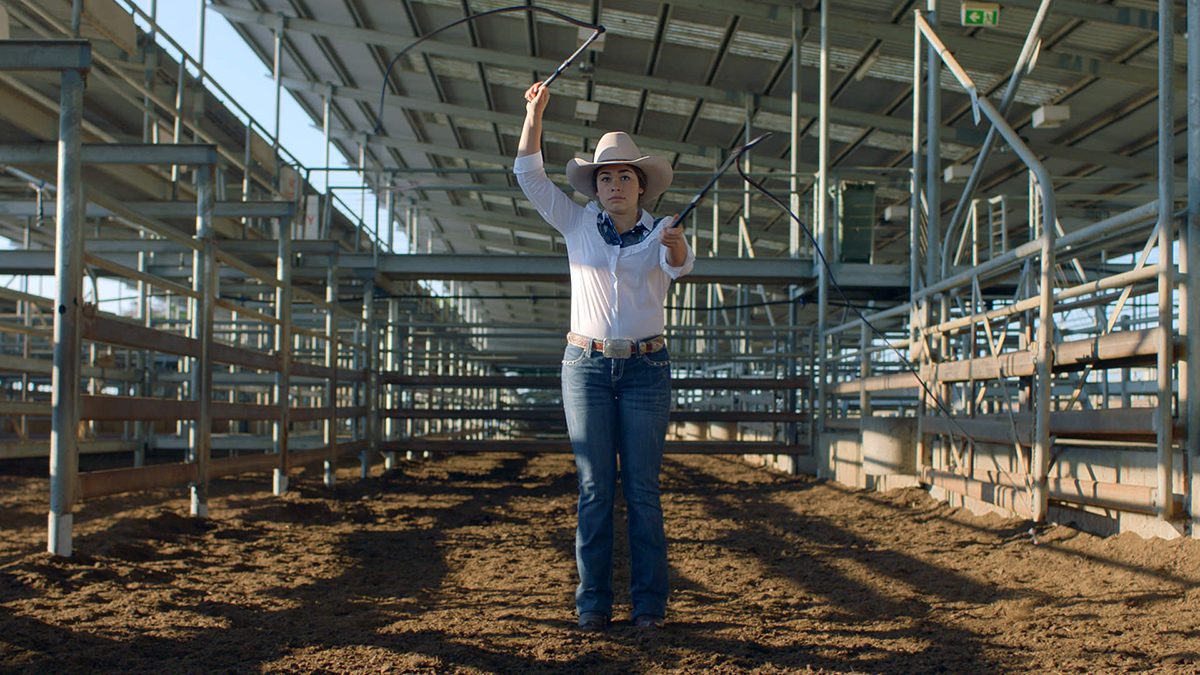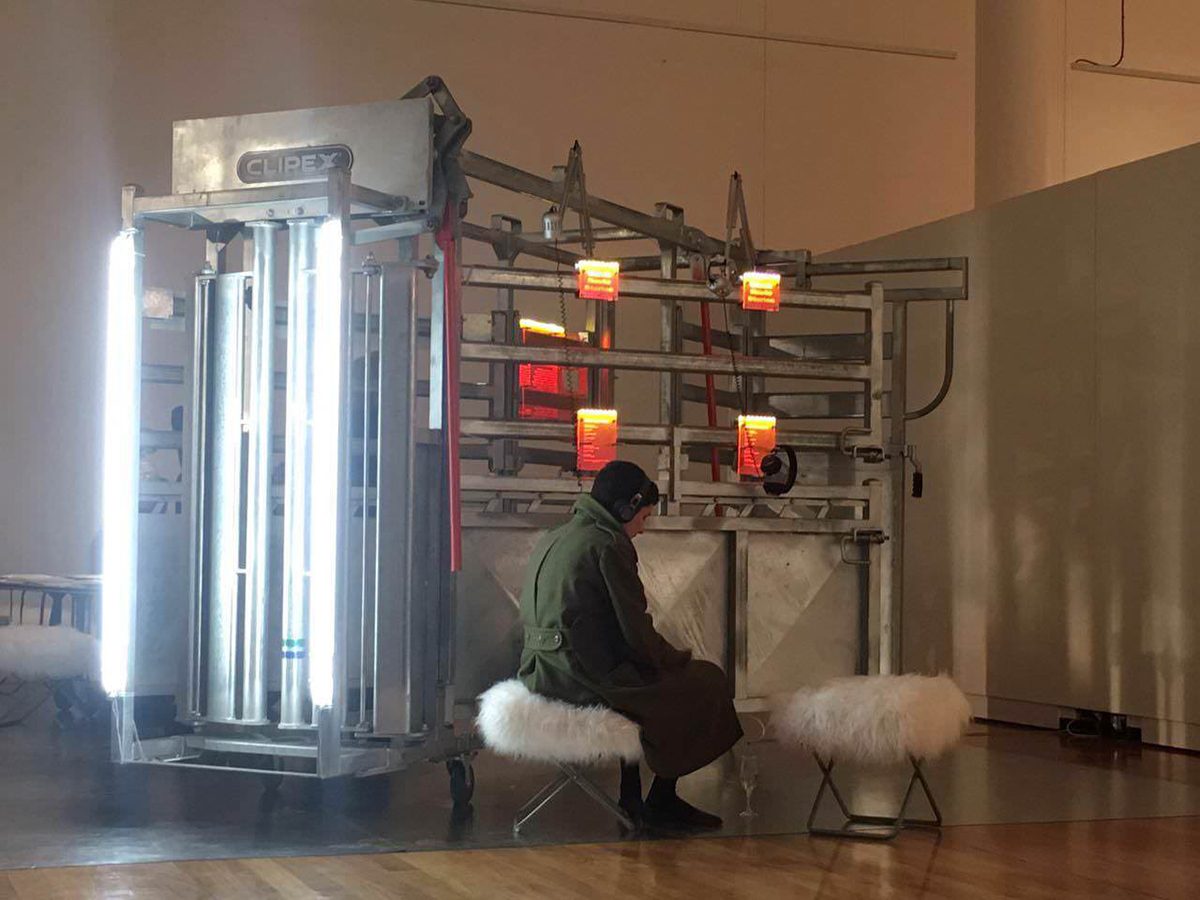In 1405, the writer Christine de Pizan produced a collection of alternative histories of women from literature and legend, interwoven with everyday observations of womanhood at the time. Unusually educated for a medieval woman, de Pizan was a champion of women’s abilities and The Book of the City of Ladies is widely considered to be the first feminist text. In de Pizan’s version of ancient European myths, women, previously represented as terrible witches by men, are recast as heroes. Through de Pizan’s desire to show women as steady, intelligent and kind, The Book of the City of Ladies shows that history as it might be written by women is very different to the one written by men.
Drawing on de Pizan’s book, Australian artist Zanny Begg and Paris-based Australian filmmaker Elise McLeod have created their own collection of women’s stories in a film titled The City of Ladies. Recently screened at the MCA as part of The National, these stories are performed by a group of seven young Parisian women who play roles that draw on their real lives as activists as well as representing aspects of contemporary feminism. The women are bound by friendship, activism and the film’s central conceit: they are all auditioning for the role of Joan of Arc in an imagined production.
The film is designed to give the audience a fragmented, partial viewing experience. Made up of modular episodes that are configured each time by an algorithm, each viewer sees a different set of events. The episodes include scenes where the women participate in activist projects, a story that follows one of the women as she confronts everyday situations and a casting session where each of them auditions. In addition, several key feminist thinkers, including 20th century powerhouses Hélène Cixous and Silvia Frederici share their knowledge in sections edited to appear as if the young women are receiving a class.

The City of Ladies (still) 2017, by Zanny Begg with Elise McLeod, courtesy and © the artists, photo Federique Baraja
These interviews and the sequences that explore individual stories are, for me, the most engaging aspects of the work. In the stories I’ve seen, themes of race, class and gender fluidity emerge.
A young French-Asian woman helps her mother clean the apartment of a wealthy white woman. Left to finish the work on her own, the girl pretends she is the owner of the apartment. She puts on a leather jacket left hanging over a chair, tests the perfume on the mantelpiece, dances to a song on the stereo and reclines on the sofa with a copy of The Book of the City of Ladies.
A young French-African woman listens to her transgender friend tell a story about a man who agrees to beat his friend’s wife to win a bet. The wife narrowly escapes being murdered and lives the rest of her life as a man. A North African woman wonders where she fits as an African woman living in France and passing for white. Sharon Omankoy discusses afro-feminism.
There are some charming moments in The City of Ladies. The women are endearingly earnest, they face-swap each other into an internet image of Joan of Arc, and there is a lot of dancing. But I struggled to place the film within the context of The National, a survey of contemporary Australian artists held across the MCA, AGNSW and Carriageworks. The National is in part about creating and establishing Australian histories and while there’s something global about all 21st century experience, each place has its own particularities that influence how issues of colonialism, globalism and migration manifest in daily life. Because The City of Ladies explores these issues as they occur in Paris, I felt unable to use them to think through my own position and experience as a young 21st century woman. For example, France’s relationship to colonialism is significantly different from Australia’s, as is the way feminism has been theorised and enacted. Perhaps this response is specific to me, but within the context of the exhibition, I was looking for Australian responses to these questions.

The City of Ladies (detail) 2017, Zanny Begg with Elise McLeod, installation view, The National 2017, courtesy and © the artists and MCA, photo Jacquie Manning
Also difficult to reconcile is the film’s body-oriented image of feminism with my own thinking about how women are imaged. The camera work is empathetic and even-handed and the film attempts to challenge mainstream ideas of feminine beauty, but, by using conventional formal techniques — in particular, continuity editing and the use of coverage that is varied and doesn’t draw attention to the image’s construction — the film fails to address questions of representation as thoughtfully as it might. For me, two key, long-running questions are the objectification of white women and the invisibility of black women. Begg and McLeod’s film engages these to some degree. Black women are present, and white women are active, but all of them are pretty and when the camera roves closely over their young dancing bodies the image is not different enough from the problematically sexualised images of young women made by men to encourage the audience to reflect on how representation influences what women become.
Perhaps the artists imagine the shots as empowered images of young women that are joyfully sexual, or as a playful riff on the notion of putting women on a pedestal — there are sequences where the women actually dance on a pedestal. But the image feels contradictory because the film grammar, in particular the slow-motion close-ups, carries a history of feminist argument that has not yet been resolved. Some of these questions around how women might be represented in a feminist context are concurrently on display in Alex Martinis Roe’s It Was About Opening the Very Notion That There Was a Particular Perspective (2017) in The National at AGNSW and they are questions that still feel pressing. There is also the question of women’s technical roles within film production. One of the most positive feminist actions is to put women behind the camera, but the DOP on The City of Ladies is male.
What stays in my mind are the interviews with feminist theorists. Thoughtful and passionate, they are, like de Pizan’s writing, a sign that things might one day be different.
–
The City of Ladies, Zanny Begg and Elise McLeod, director of photography Laurent Chalet, performers Marie Rosselet Ruiz, Tasmin Jamlaoui, Sonia Amori, Juliette Speck, Coline Beal, Garance Kim, Katia Miran, voice David Seigneur, audio design James Brown, music Mere Women, La Catastrophe, La Parisienne Libérée; The National, curator Blair French; MCA, Sydney, 30 March-18 June
Sarinah Masukor is a writer and moving image maker. Her writing on film and contemporary art has been widely published here and overseas. She has worked as a presenter and critic for ABC Arts and Radio National and currently teaches Media Arts and Production at UTS.
Top image credit: The City of Ladies (still) 2017, Zanny Begg with Elise McLeod, courtesy and © the artists, photo Federique Baraja
Large, geodesic, candy-pink: at first appearance Future Method Studio’s Buckminster Fuller-inspired dome tent, filled with white pebbles and bits of flint, is a surprising presence in a gallery show about Australia’s long paddock. That phrase—long paddock—is a colloquialism, a settler-colonial buzzword for the travelling stock routes (TSRs) that once traversed and now patchwork the continent. Joni Taylor from the New Landscapes Institute has curated a show situated at the intersection of architecture and art that explores the layered histories of the TSRs at a time when access to public land is more contentious than ever. The exhibition is the first iteration of a long-term project engaging with the uncertain future of this important public resource.
Classified as crown land, today TSRs are liminal zones used for myriad purposes. Farmers, birdwatchers, beekeepers, bushwalkers, ecologists and traditional owners all have a stake in their future. Up on the gallery wall, near the dome, Future Method Studio has created a map that charts the locations across NSW where the TSRs intersect with places of Aboriginal significance. It’s an impressively detailed and important document and to my knowledge no other map like it exists.
As the artists in this show acutely understand, the problem with maps is that they formalise a kind of forgetting. By prioritising one set of concerns, others fade away. Living and working in the Riverina, The Wired Lab (see a 2014 RealTime TV interview with director Sarah Last), are particularly sensitive to this, using two different maps, one historical, one spatial, to contextualise a mesmerising soundscape featuring local activist Peter Beath speaking in Wiradjuri—a language declared extinct in 2007 but which in fact survives—and field recordings from TSRs local to the area, a lively racket of cicadas, birds and insects. It’s The Wired Lab work, Lines of movement, a Wiradjuri history, that feels the most essential; human and non-human occupants are given equal ground from which to speak.
Looking at the TSRs from an economic perspective led artist Zanny Begg to the bullwhip effect, an economic term that describes accelerating unpredictability within complex supply chains. The bullwhip is also a uniquely Australian whip and the first human invention with the capacity to break the sound barrier. Begg’s film, The Bullwhip Effect, features a virtuosic demonstration by 17-year-old Emiliqua East, one of the world’s best whipcrackers. Slowed down to 200 frames per second, she becomes a medusa-like figure, totally focused, barely blinking, two whips writhing and cracking around her with stunning precision. Shot and soundtracked in a manner that playfully engages Western genre tropes, East enters and exits the film walking slowly through a labyrinthine, stainless steel cattleyard.
In Untitled Incognito, Megan Cope and Bill Buckley present a reworked version of an Aboriginal windbreak made from a mix of traditional and non-traditional materials. Its ochre-painted surface is used as a screen, onto which two images are overlaid: rippling water from the Murrumbidgee and a map of local TSR coordinates. The work asks important questions about who the TSRs are for, and what they might become. As of April the NSW TSRs have been placed under formal review. What if this land were to be repatriated to traditional owners?
Architecture collective Grandeza offers a global perspective in The Plant, presenting a case study on similar stock routes throughout Spain. Alongside this, they have created a portable conversation arena and an adapted version of the cattle crush (a holding stall), programmed with recordings from members of the community telling their stories about the TSRs. The architectural contributions of both Grandeza and Future Method Studio bring a sense of public agency into the gallery and activate the exhibition as a site of political action.
Back to the dome, which on closer inspection represents the concept of “a keeping place” — a place where Aboriginal cultural materials are held safely. Setting aside places as symbolic space where Aboriginal systems can be honoured is a concept that has been written into bureaucratic systems; for example, there are keeping places held on-site at mining locations where artefacts have been incidentally dug up. Cultural items are stored temporarily and then repatriated once the land is no longer being used.
In Future Method Studio’s Future Acts, the keeping place marks an important moment in their research. While they were at a stock route location, artists from the Studio and their Aboriginal collaborators came across a significant number of Aboriginal artefacts sitting in the topsoil. The experience resonated in two ways: it showed just how twinned the relatively recent history of the stock routes is with the long history of Aboriginal land custodianship. And it showed just how bad whitefellas have been at seeing what’s in front of them. The pink dome, a shape that recalls the activist politics of the US counterculture movement, operates recursively, as aura and totem. Presenting and representing the concept of keeping place, a warm ethics of care washes over the gallery as a whole.
—
The Long Paddock, curator Joni Taylor of New Landscapes Institute, artists Zanny Begg, Megan Cope & Bill Buckley, Hayden Fowler, Future Method Studio, Grandeza, Josephine Starrs & Leon Cmielewski and The Wired Lab; Wagga Wagga Art Gallery; 6 May-17 July
Emily Stewart is poetry editor at Giramondo Publishing and a doctoral student in the Writing and Society Research Centre at WSU. She is the author of Knocks (Vagabond Press 2016).
Top image credit: Future Method Studio, Rylestone Travelling Stock Route, fieldwork for The Long Paddock, 2017, photo Rosie Krauss





